It is true: seeing remnants of the brutal trans-Atlantic slave trade is an utterly different experience in Africa than in America.
Throughout our lives as Americans, we study slavery and its legacy, reading textbooks, going to museums, hearing guest speakers, writing reports, and seeing movies. It rips your heart out, but America must never stop remembering!

When you enter the doors of Cape Coast slave castle in Ghana, however, you realize: there is a whole new part of your heart to bleed.
The new sadness you will feel upon seeing a slavery exhibit in Africa is partially due to this: the majority of the other tourists are African, and (of course) the vast, vast majority of the fellow humans you pass on the street before and after entering the castle are African.
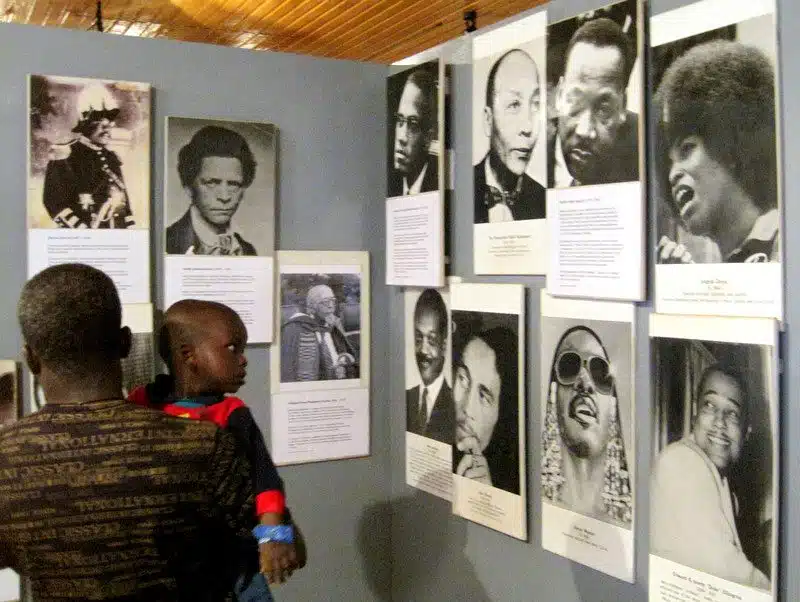
All of a sudden it becomes clear: THIS was the land from which people were ripped from their lives, right here… THESE were the people. For flashes throughout the day, you are seized with images of horror; you choke back tears.
The day before Dan flew back to America, our Ghanaian colleague, John took us the six hours West from Sogakope (where we are volunteering in schools) to Ghana’s Cape Coast slave castle.
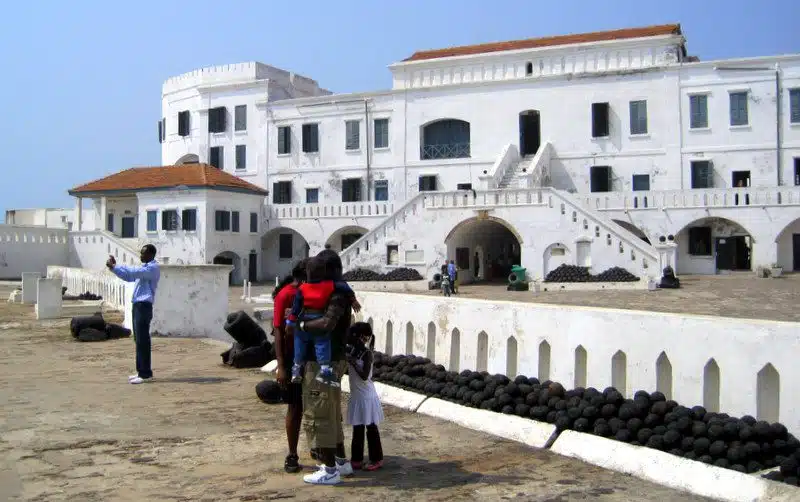
In the hectic Accra bus depot before our tro tro roared off into the darkness, a young preacher popped his head in the door. A sad-looking woman gave him fifty pesewas to preach for our safety and the young man began fervently blessing us, blessing the driver, blessing the engine, blessing the wheels.
Once the tro tro was racing along the bumpy road, I became thankful he had. “Brutal,” muttered Dan as hour four rolled around and our legs and backs had become numb from being squeezed tight between twelve people and a jabbing seat.
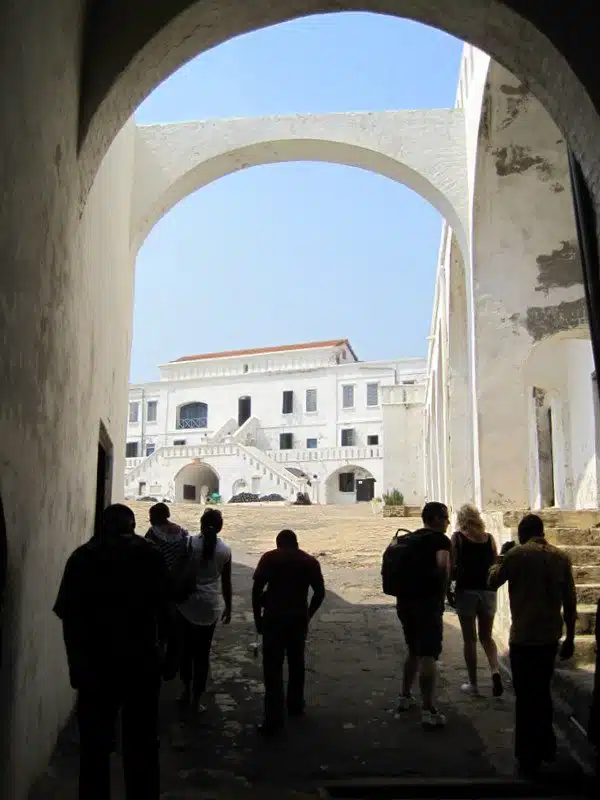
Emerging into Cape Coast late at night, taxi drivers descended upon us, hustling rides. Cape Coast is Ghana’s premier tourist attraction, and thus the sellers are far more aggressive than in loving Sogakope.
Thankfully, John knew just where to go, and led us with ease; he has been to Cape Coast almost a dozen times for educational tours, both for volunteers and as a reward for eager young Ghanaian students who had never left the Volta region.
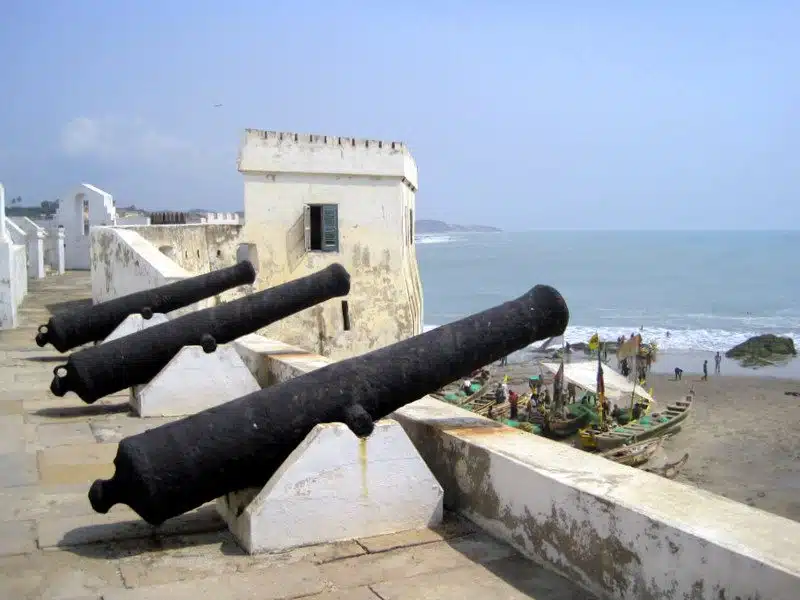
We slept, we woke, we ate, and we talked about Dan’s wonderful three weeks in Ghana and how much he would miss it. And then we pulled on our hats and stepped out into the blazing sun to walk to the castle.
The Brandt guidebook says it: Cape Coast Castle looks far too beautiful on the outside for such a horrific history. The mammoth building’s smooth white walls soared up towards the turquoise sky and behind it all we could see the foamy sea.
“The tour will begin in thirty minutes, so please start with the museum,” said the guide.
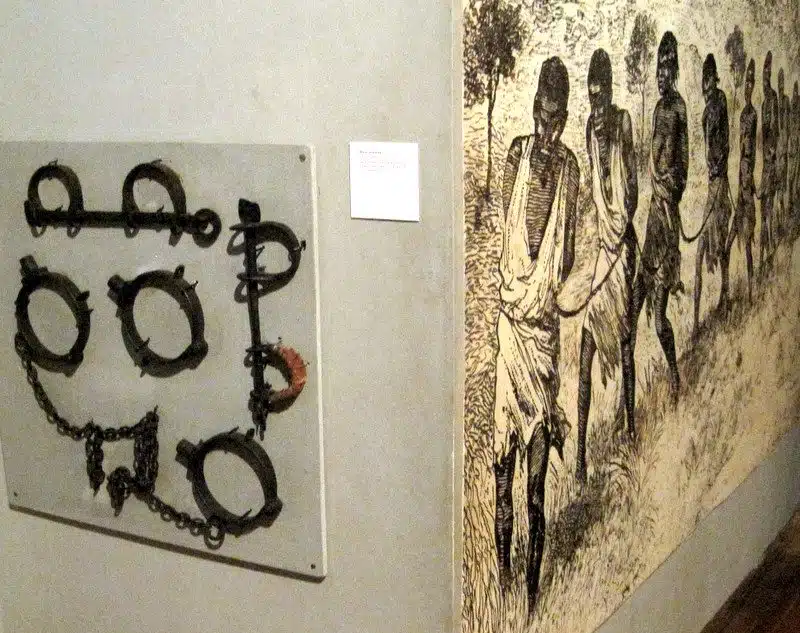
Up the stairs, past the cannons, into the hot exhibit hall. It was here that the sadness began to hit.
“Scholars debate about the total number of Africans caught in the slave trade, but estimates range from 12 million to 25 million,” read the sign.
On the wall was a display case with actual neck, leg, and arm shackles used to enslave West Africans. Next to it was a diagram of a slave ship. Words fail you. I stared at the diagram, remembering how uncomfortable we had been for a mere four hours in a tro tro.

Rage seethes against the monsters who forced their fellow humans to lie like lifeless, decaying meat for the endless journey, packed together in feces and urine, chained, despairing.
The tour began. Our tour guide was one of the best I have ever had, because he spoke like a poet, stringing words together into a song, raising his voice in rhythm, and truly speaking from the heart.
There were several small children on the tour, and whenever one would cry, our guide would effortlessly scoop her up into his arms and cuddle her until she smiled. Many of these toddlers preferred to stay in the guide’s strong arms than to go back to their mothers!
Our guide led us across the burning hot courtyard to a black metal door marked “Male Slave Dungeon”. He pointed to the rooms above and said, “Right on top of the dungeon was the castle’s… church. Before the Africans were pushed into the dungeon, they were anointed, and thus they became slaves in the name of God.”

The heavy door creaked open and we descended into a dark, dank cave. We made a right and found ourselves in a fetid womb of earth and stone. Suddenly, the lights snapped off and we screamed. You could hardly see, and the tiny air holes high above hardly allowed sunlight. I couldn’t remember which way was the entrance.
“Click!” the lights came on again and our guide was looking at us. “That was how it was,” he said, simply. “I wanted to show you.”
The guide went on to explain that thousands of captured Africans festered in this hellhole before being shipped off to slavery.
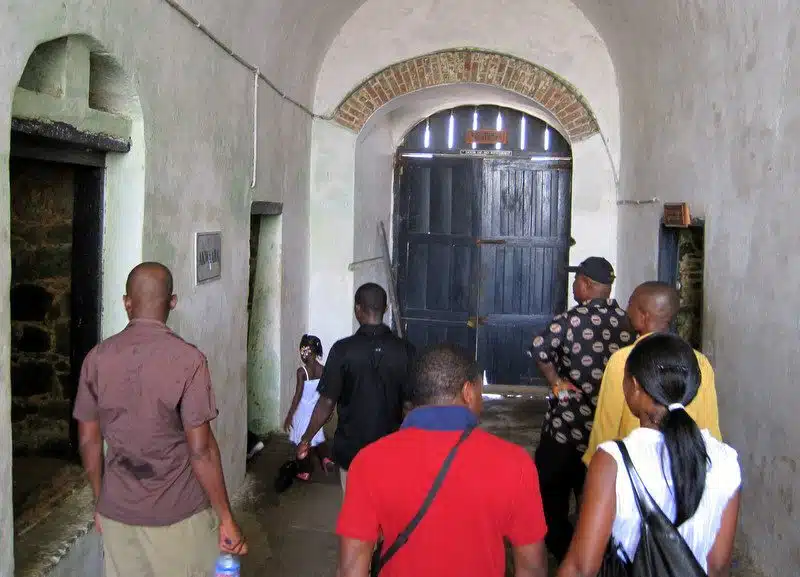
The only drainage was a one-inch-wide gutter in the middle of the floor, meaning that the men in this cell were constantly sitting in feces, urine, vomit, and decaying bodies.
He pointed to a white chalk mark in the middle of the wall. “When UNESCO came to clean out this room in order to turn the castle into a museum, the sludge of human excrement and bones was that high.”
We held our hearts and felt nauseous.
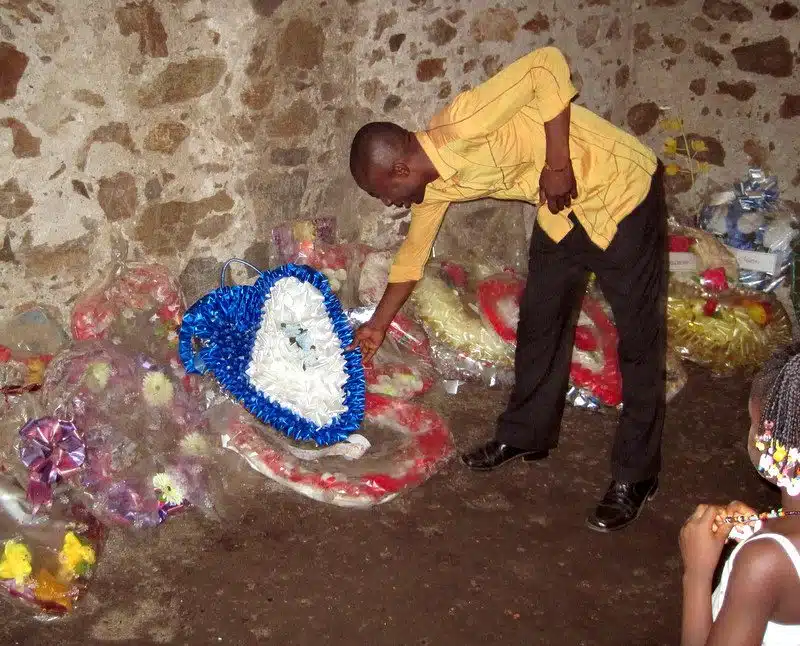
Through another cave passageway we went, and then into another stone and dirt chamber. “This is the shrine,” said our guide, “that has been created to honor our ancestors and how they suffered. Many people come and they leave offerings, and if you look at that blue and white heart over there, you may know that the person who donated it was Barack Obama, president of the United States, when he visited here in July of 2009. If you would like to touch something that President Obama touched, you may do so.”
Everyone reverently paid homage to the shrine, then lovingly touched the vibrant heart.
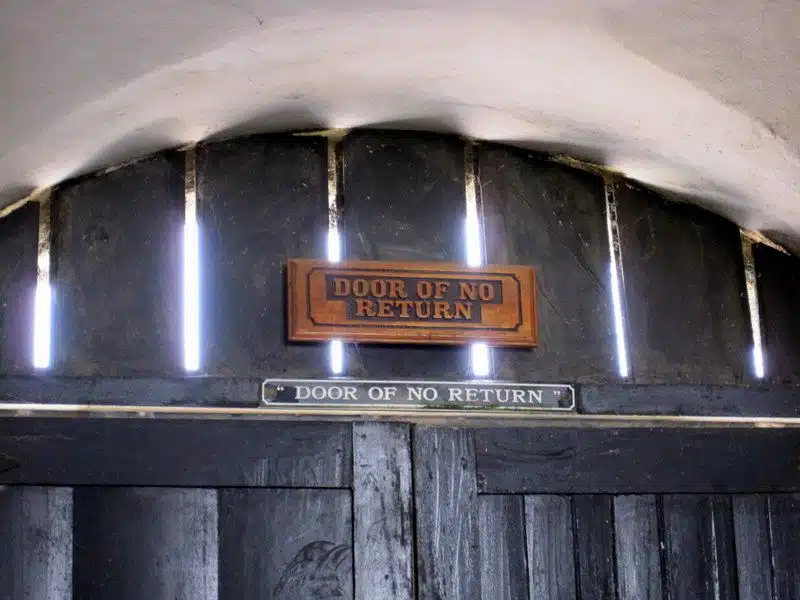
The tour led us through the graves in the courtyard, past the cistern (which is still used today for water), and then: to the Door of No Return.
Sunlight sliced in through the slits in the heavy wood, and we sighed, knowing that tens of thousands of Africans walked through this portal into forced labor and early death across the endless ocean.
We walked through.
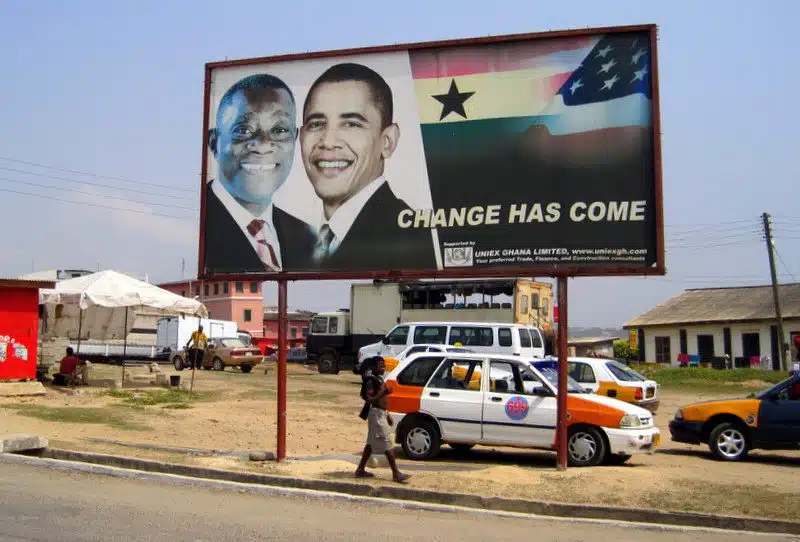
Outside, the scene takes your breath away. Life! Rainbow-colored boats line the crashing surf, children cavort in the water, fishermen ready their nets, and women stride by balancing wares on their heads to sell. The first and last photos of this article are of that view.
The guide pointed to the top of the giant door on this side. “Several years ago, African-American descendants of slaves were invited to voyage here, and they decided to create a new sign to usher in a new era.”
We gazed at the letters. They read: “DOOR OF RETURN.”

The tour concluded at the center of the courtyard, and there our guide sang out:
“In everlasting memory
Of the anguish of our ancestors
May those who died rest in peace
May those who return find their roots
May humanity never again perpetuate
Such injustice against humanity
We, the living, vow to uphold this.”

The author, Lillie Marshall, is a 6-foot-tall National Board Certified Teacher of English, fitness fan, and mother of two who has been a public school educator since 2003. She launched Around the World “L” Travel and Life Blog in 2009, and over 4.2 million readers have now visited this site. Lillie also runs TeachingTraveling.com and DrawingsOf.com. Subscribe to her monthly newsletter, and follow @WorldLillie on social media!

Diana P
Tuesday 17th of November 2015
This is very inspiring to see people go through such a rough time. I find it quite interesting about how the area can make you feel an emotion you may not be able to feel in general. Thanks for the article Ms. Marshall!
James D
Monday 16th of November 2015
These pictures of the dungeon caused a mixture of emotions, but lucky they have a beautiful coast. Great facts and pictures Ms. Marshall!
Luca A
Wednesday 25th of February 2015
Wow. I cannot imagine getting ripped out of your life. I don't think I could even imagine what these people felt when they are just taken out to work for someone they don't even know. Also the part where your guide said “When UNESCO came to clean out this room in order to turn the castle into a museum, the sludge of human excrement and bones was that high.†That is two things. First, messed up. Second, creepy.
Rachel W
Tuesday 17th of November 2015
I feel really bad for the people who were stripped away from their families to work for someone they don't know. I also feel strongly about the sludge of human excrement and bones. That is just so wrong and creepy.
Lizzie F.
Wednesday 25th of February 2015
Wow Ms. Marshall! This tour seems so interesting, scary, and sad. It was so sad to see the dungeon where all the slaves were kept. But lucky there was a beautiful coast right outside the Cape Coast slave castle.
Vanessa Blaylock
Saturday 31st of August 2013
Hi Lillie, I recently discovered your blog / life / work. I already forget the exact "internet serendipity" path that led me, but anyway, it's a beautiful, joyous (ok, THIS post a little less joyous) celebration of life.
It's always funny to look from any "modern" moment back in time. When you think about something as radical as slavery you just have to scratch your head hard, What were "they" thinking. Of course, "they" is "us," just in another context.
I really liked Lee Daniels' The Butler. All of the challenge and strife in that film is "post slavery." We like to feel more enlightened in 2013, but are we? Female genital mutilation. This year Ai Weiwei is actually out of prison, but Pussy Riot is in prison. Aaron Swartz is dead. Chelsea Manning sentenced to 35 years for telling the truth. Edward Snowden running. Julian Assange under house (embassy) arrest. And of course the many online platforms where we weave the tapestry of our virtual lives exert subtle, and sometimes not so subtle, pressure for us to live our lives in conformance to the needs of their platform.
Maybe none of those things rise to the magnitude of what you saw and considered today. But even if the magnitude is less, perhaps far less, I nonetheless believe that the themes of oppression and marginalization are similar. Have we really progressed? Or do we just oppress different people in different ways?
One thing at least, all that stuff about freedom and liberty and eternal vigilance, it's so true. If you believe in a world of civil rights, it seems like you have to struggle for it every single day.
And, OhHowFunny... I think you just tweeted this post... and I was going to say, "Aren't you expecting?" And, "wait, you're in Ghana??" But I see now that this post is from 2010! But the tweet is new. Yay for the Internet & the Long Tail! :)
Anyway, I think you are expecting, so best wishes new mommy to be! As I said at the top your blog & life & work & activities seem to function so well together. It's always inspiring to see your work. Even, paradoxically, when it is a difficult a post as this one.
Thank you Lillie!
Lillie
Saturday 31st of August 2013
Vanessa, So glad you found me! Thank you for reading and for your thoughtful comment. Do be in touch!